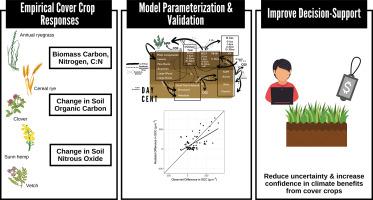Agricultural Systems ( IF 6.6 ) Pub Date : 2021-04-23 , DOI: 10.1016/j.agsy.2021.103151 Shelby C. McClelland , Keith Paustian , Stephen Williams , Meagan E. Schipanski

|
CONTEXT
Cover crops deliver numerous ecosystem services including the capacity to sequester and store atmospheric CO2 offering promise as a natural climate solution. Farm system models must be able to accurately represent cover crop systems and estimate the associated net greenhouse gas emissions from this practice across agricultural contexts.
OBJECTIVE
The objectives of this study were to: (1) parameterize new and existing cover crop species for DayCent – the biogeochemical model behind the decisions-support tool, COMET-Farm – using published data on cover crop biomass production, (2) validate differences between cover crop and control systems using published and long-term data from across the U.S. for SOC and N2O emissions, and (3) evaluate model performance and discuss improvements to cover crop data reporting to facilitate future testing.
METHODS
We used published field experiment datasets from across the U.S. to estimate cover crop biomass production, SOC, and soil N2O emissions. We parameterized one new cover crop species in the model – sunn hemp (Crotalaria juncea L.) – and revised the parameters for existing model cover crop species using new biomass observations. We also validated the ability of the model to estimate changes in SOC and soil N2O emissions relative to a no cover crop control using empirical observations.
RESULTS AND CONCLUSIONS
For data sets used in parameterization, DayCent reasonably captured observed trends in aboveground biomass C, N, and C:N ratios across six different cover crop species and mixtures, explaining 25–69%, 14–58%, and 29–50% of the variation, respectively, with a few exceptions. Using a smaller validation dataset for a subset of these cover crop species – cereal rye (Secale cereale L.) and vetch (Vicia spp.) – the model demonstrated less agreement between modeled and observed aboveground biomass. For SOC model validation, the observed mean SOC difference between cover crop and control treatments was 178.4 g m−2 and the mean modeled difference was 158.2 g m−2. Observed soil N2O emissions were highly variable impacting model performance, but DayCent did capture the general trend from field measurements for cover crops to suppress soil N2O emissions.
SIGNIFICANCE
Our results demonstrate that even under limited data availability, process-based models like DayCent can inform on farm-scale biogeochemical processes under cover cropping. These findings are critical as cover crops are more widely adopted in the United States for their climate and environmental benefits. However, more detailed reporting from empirical studies will improve model estimates and reduce uncertainty, particularly data pertaining to farm management, soil, climate, and location.
中文翻译:

对农作物生物量产量和相关排放量进行建模,以改善农场规模的决策支持工具
语境
覆盖作物可提供多种生态系统服务,包括封存和存储大气中CO 2的能力,这有望成为一种自然气候解决方案。农场系统模型必须能够准确地表示覆盖作物系统,并根据农业环境中的这种做法估算相关的温室气体净排放量。
客观的
这项研究的目的是:(1)使用DayCent(决策支持工具COMET-Farm背后的生物地球化学模型)参数化DayCent的新的和现有的覆被作物种类,使用已发布的覆被作物生物量生产数据,(2)验证两者之间的差异使用美国各地已发布的长期和SOC和N 2 O排放数据来覆盖作物和控制系统,以及(3)评估模型性能并讨论覆盖作物数据报告的改进,以方便将来的测试。
方法
我们使用了来自美国各地的已发布的田间实验数据集来估算农作物生物量产量,SOC和土壤N 2 O排放量。我们在模型中参数化了一种新的覆盖作物物种– sunn hemp(Croctalaria juncea L.)–并使用新的生物量观测值对现有模型覆盖作物物种的参数进行了修改。我们还通过经验观察验证了该模型相对于无盖作物控制估算SOC和土壤N 2 O排放变化的能力。
结果与结论
对于参数化中使用的数据集,DayCent合理地捕获了六种不同覆盖作物物种和混合物中地上生物量C,N和C:N比率的观测趋势,解释了其中25%至69%,14%至58%和29%至50%的趋势。的变化,分别有几个例外。对于这些覆盖农作物物种的子集(谷物黑麦(Secale graine L.)和紫etch(Vicia spp。))使用较小的验证数据集,该模型显示出模拟的和观察到的地上生物量之间的一致性较弱。为了进行SOC模型验证,观察到的覆盖作物和对照处理之间的平均SOC差异为178.4 g m -2,模型化的平均差异为158.2 g m -2。观测土壤N 2O排放量对模型的性能影响很大,但是DayCent确实从田间测量中获得了覆盖作物抑制土壤N 2 O排放量的总体趋势。
意义
我们的结果表明,即使在有限的数据可用性下,基于过程的模型(如DayCent)也可以为覆盖种植下的农场规模生物地球化学过程提供信息。这些发现是至关重要的,因为美国由于其气候和环境效益而更广泛地采用覆盖作物。但是,来自实证研究的更详细的报告将改善模型估计并减少不确定性,尤其是有关农场管理,土壤,气候和位置的数据。



























 京公网安备 11010802027423号
京公网安备 11010802027423号